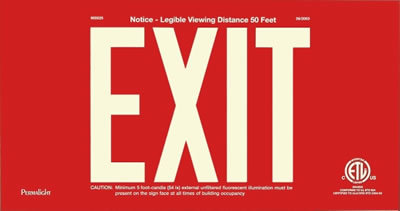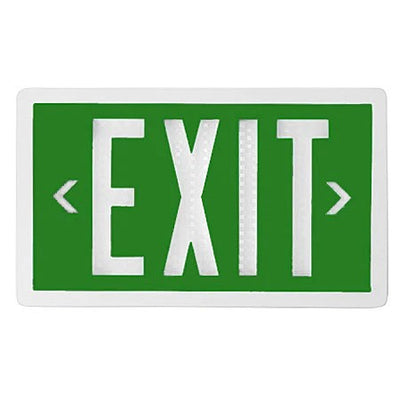What’s Included in This Guide
Overview

Photoluminescent exit signs, also known as glow-in-the-dark exit signs, are non-electric egress markers that absorb ambient light and emit a greenish glow in the dark. These signs are powered by photoluminescent pigments—usually strontium aluminate—which store light energy when exposed to a light source. During a power outage or blackout, they emit that stored energy as a visible glow that helps guide people to safety.
Unlike traditional LED or battery-powered signs, photoluminescent exit signs contain no electronics, no wiring, and require no ongoing electricity. Once installed in a properly lit environment, they automatically charge and recharge with available light, making them ideal for energy-efficient buildings, remote areas, and facilities seeking low-maintenance safety solutions.
Brightness, Charging, and Lifespan
Photoluminescent exit signs glow with a visible green hue once the lights go out. While they are not as bright as electric exit signs, they are designed to meet the visibility standards required by code—typically legible from 50 to 100 feet in complete darkness.
Under ideal charging conditions, these signs can emit usable light for at least 90 minutes (meeting NFPA 101 and UL 924). Many models continue glowing for up to 15 to 95 hours depending on the pigment formulation and how long they were exposed to charging light.
To charge fully, photoluminescent signs require at least 5 foot-candles (54 lux) of ambient light for a minimum of 60 minutes. Most office lighting, hallway fixtures, or stairwell lights easily satisfy this requirement.
Lifespan: Unlike battery-based exit signs, photoluminescent models have no moving parts or electronics. They often last over 25 years with minimal performance loss—making them a top-tier low-maintenance solution for long-term exit signage.
Safety and Compliance Requirements
Photoluminescent exit signs are required to meet the same rigorous safety codes as their electrical counterparts. In the United States, all exit signs must comply with UL 924, which certifies emergency lighting and exit signage for visibility, durability, and illumination performance.
Photoluminescent signs are also accepted under NFPA 101 (Life Safety Code), IBC (International Building Code), and OSHA regulations, provided they are UL 924 listed and installed according to manufacturer specifications.
Key requirements include:
- Minimum 90 minutes of illumination after power loss
- Clearly visible and legible text (6-inch letters with 3/4-inch stroke)
- Proper charging light source (minimum 5 foot-candles of light on sign face)
- Installation in locations where lights remain on during building occupancy
These signs are suitable for any jurisdiction that accepts UL 924 exit signage and are often used in both commercial and institutional settings where low maintenance and energy efficiency are priorities.
Ideal Use Cases
Photoluminescent exit signs are ideal for buildings that prioritize energy efficiency, reduced maintenance, or require signage where electrical wiring is impractical. Common applications include:
- Stairwells and Emergency Corridors: Constant lighting ensures reliable charging and long-lasting glow.
- Historic or Hard-to-Rewire Buildings: Perfect where routing new electrical circuits is disruptive or expensive.
- LEED-Certified or Sustainable Buildings: Energy-free operation supports green building goals.
- Warehouses and Industrial Sites: Offers maintenance-free performance in hard-to-reach areas.
- Secondary Backup to Electric Exit Signs: Adds passive redundancy in case of battery or power failure.
As long as the area has consistent ambient light and occupancy, photoluminescent exit signs provide a simple, durable, and reliable egress solution with no ongoing power draw.
Installation, Inspection, and Testing
Photoluminescent exit signs are simple to install because they do not require electrical connections. Most can be mounted with screws, brackets, or adhesive depending on wall material and manufacturer guidance.
Key installation points:
- Ensure the sign face receives at least 5 foot-candles of continuous ambient light during occupancy
- Mount signs at standard exit heights (typically above doors or along egress paths)
- Do not install in shaded areas or places where overhead lighting may be turned off
Monthly Inspection: As required by NFPA 101, perform a visual inspection monthly to verify the sign is undamaged, unobstructed, and that the charging light source is functioning properly.
Testing: Perform an annual darkness test by shutting off the area’s lighting and ensuring the sign glows brightly for at least 90 minutes. Document test results in your emergency lighting log.
If your application supports wiring and you'd prefer an electrically powered model, browse our full exit signs collection for a range of hardwired and battery backup options.
Non-Electric Exit Sign Alternatives

While photoluminescent exit signs are a popular non-electric option, they’re not the only one. Another reliable power-free alternative is the self-luminous tritium exit sign.
Photoluminescent signs work by absorbing and re-emitting light, while tritium signs use a low-level radioactive isotope to continuously glow—without needing any external light or power source.
Photoluminescent Signs (Glow-in-the-Dark)
- Require a consistent light source to recharge
- Eco-friendly, no electricity or batteries
- Long lifespan (20+ years), minimal maintenance
- Must be installed in well-lit environments
Self-Luminous Tritium Signs
- Do not require ambient light or electricity
- Perfect for dark environments or isolated areas
- Typical lifespan of 10 to 20 years
- Require regulated disposal due to radioactive content
For areas that remain dark, are hard to maintain, or cannot guarantee sufficient lighting, tritium exit signs are a great fit. Otherwise, photoluminescent signs are ideal for most energy-conscious, well-lit buildings.
Conclusion and Additional Tips
Photoluminescent exit signs are a simple, energy-free, and highly reliable solution for egress signage in well-lit environments. They charge from ambient light and glow clearly during emergencies—without the need for electricity, batteries, or maintenance.
They’re ideal for stairwells, LEED-certified buildings, historic structures, and anywhere low-maintenance, code-compliant signage is needed. When paired with routine visual inspections and installed where lighting remains consistent, these signs can function effectively for over 25 years.
- Ensure consistent lighting: The most common issue with photoluminescent signs is undercharging. Keep surrounding lights on while the building is occupied.
- Use where wiring is impractical: No electrical lines are needed, making them a good fit for masonry walls, glass partitions, or inaccessible ceilings.
- Stay compliant: UL 924 listings, proper mounting, and documentation of visual inspections keep you on the right side of code.
For most commercial and institutional spaces, photoluminescent exit signs are a long-lasting, low-cost solution that supports both safety and sustainability goals.
